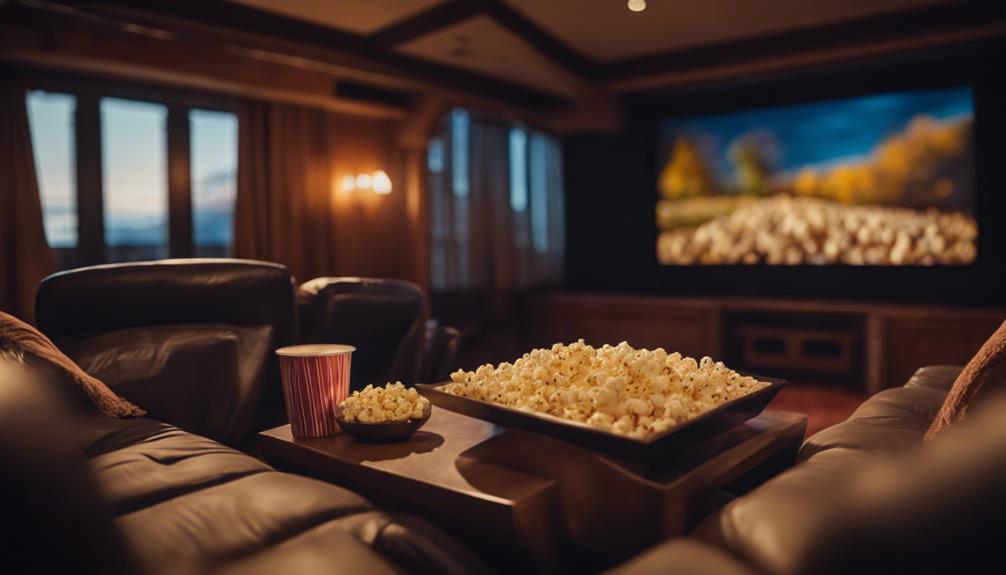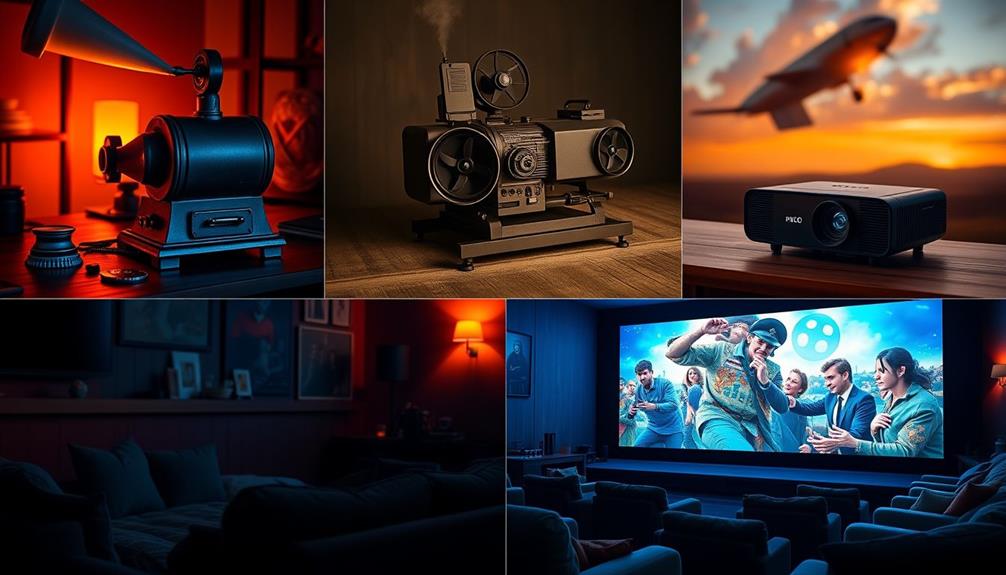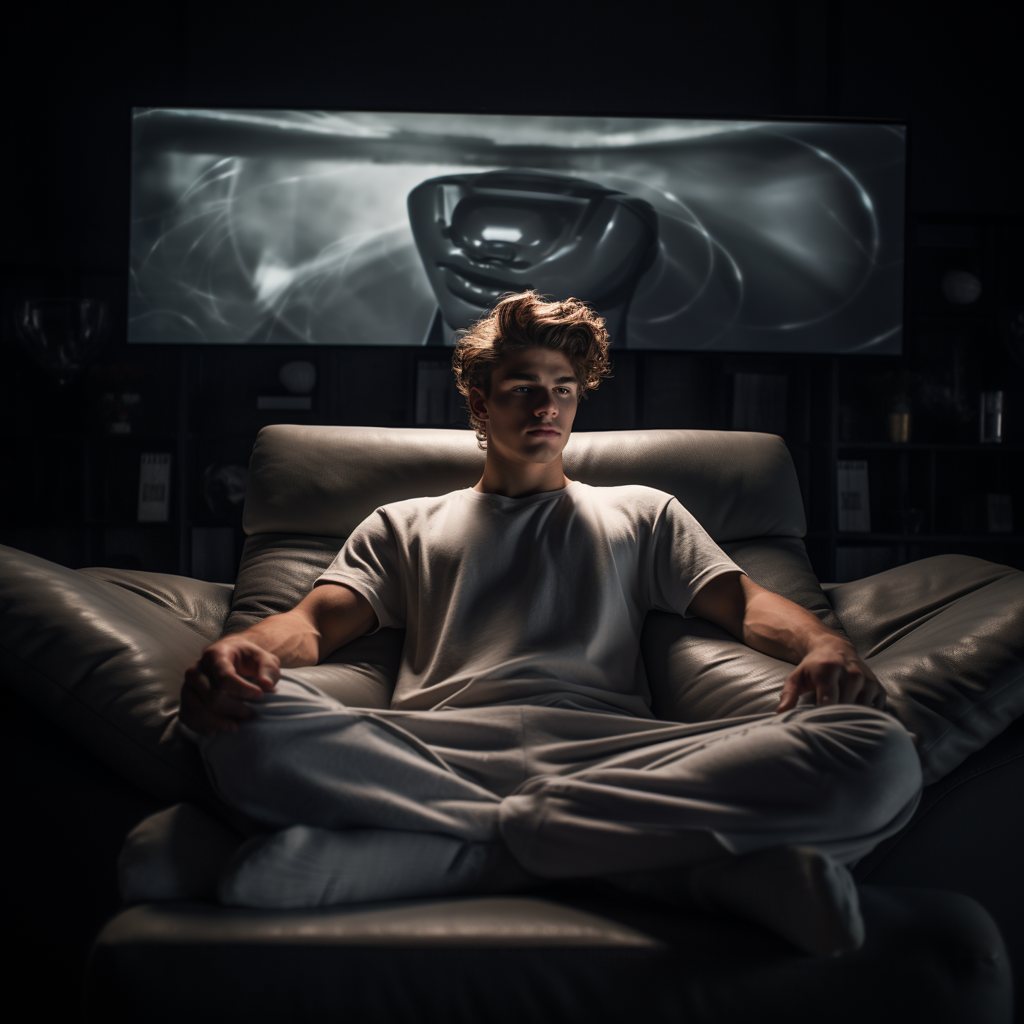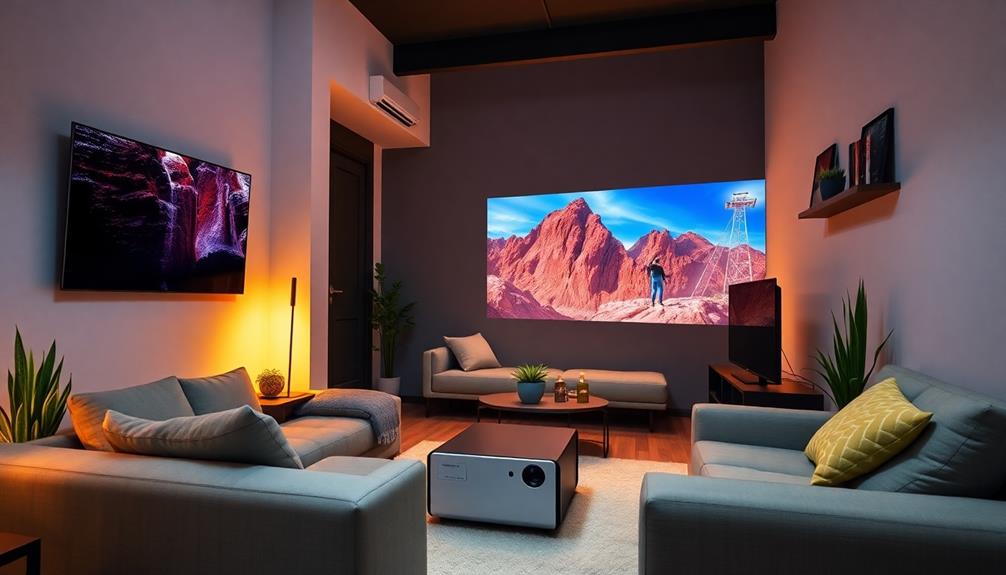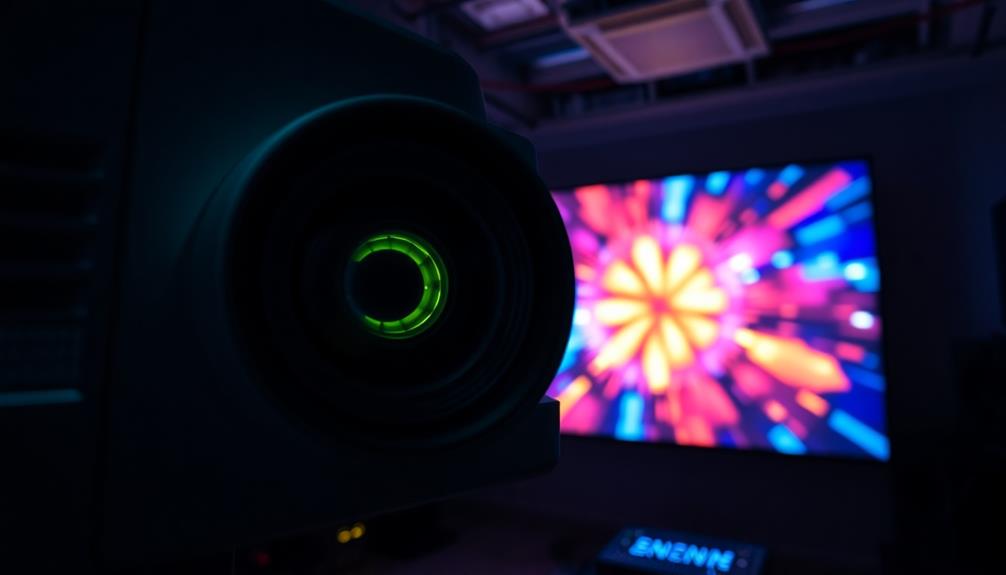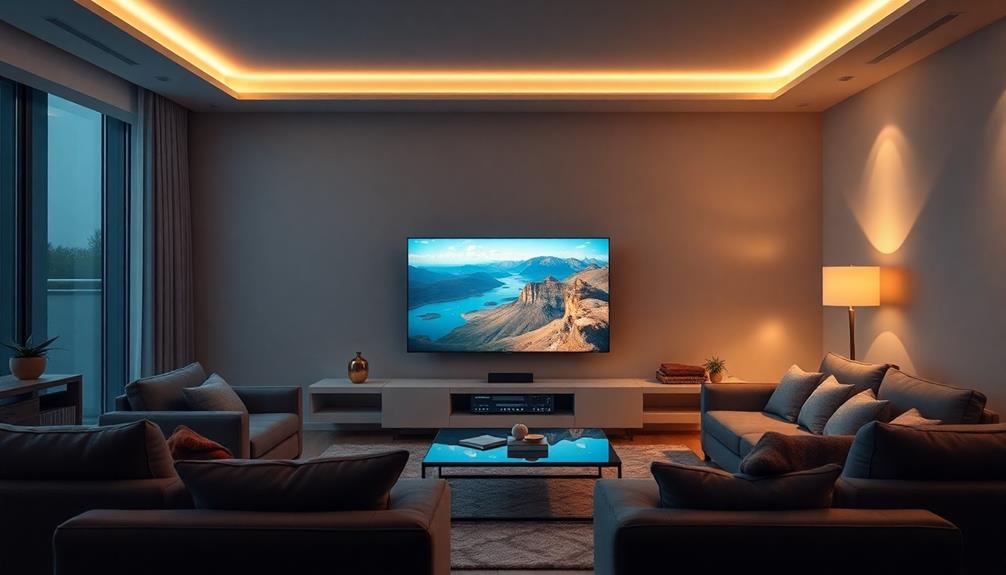Cinemascope aspect ratio, usually around 2.35:1 or 2.39:1, truly enhances your home theater experience. It offers a wider field of view, making you feel more engaged in the film's visuals and emotional impact. This format minimizes black bars and guarantees compatibility with most blockbuster films, giving you a seamless viewing experience across various content. Plus, with large screens, you can appreciate the intricate details that bring stories to life. By embracing this cinematic style, you create a more immersive atmosphere in your home. There's plenty more to explore about how it can elevate your movie nights.
Key Takeaways
- Cinemascope aspect ratio (2.35:1 or 2.39:1) enhances immersion, capturing expansive visuals that deepen viewer engagement with the narrative.
- Large screens, especially 150-inch diagonals, maximize the immersive experience by minimizing black bars and showcasing rich cinematic details.
- This format is compatible with most blockbuster films, ensuring minimal distortion and a seamless viewing experience across various aspect ratios.
- Lens memory technology allows effortless transitions between aspect ratios, preserving film integrity while enhancing the overall cinematic experience.
Definition of Cinemascope Aspect Ratio
The Cinemascope aspect ratio, often seen as 2.35:1 or 2.39:1, offers a wider field of view that enhances your cinematic experience by filling more of your peripheral vision.
This Cinemascope format was introduced in the 1950s, primarily to provide an immersive viewing experience, especially for epic films. By capturing expansive landscapes and intricate details, it allows you to feel more connected to the story unfolding on screen.
One of the main advantages of the Cinemascope aspect ratio is its ability to minimize the cropping of original film content. This precision helps preserve the filmmakers' artistic vision, ensuring that you experience the movie as intended.
When you're watching a film that uses this format, you're less likely to see those distracting black bars at the top and bottom, which can detract from your engagement.
With the increasing popularity of 21:9 televisions and projectors, the Cinemascope aspect ratio has become a go-to choice for home theaters.
It caters to consumers who crave a more authentic cinematic experience, transforming your living room into a mesmerizing viewing environment.
Enhanced Immersive Experience
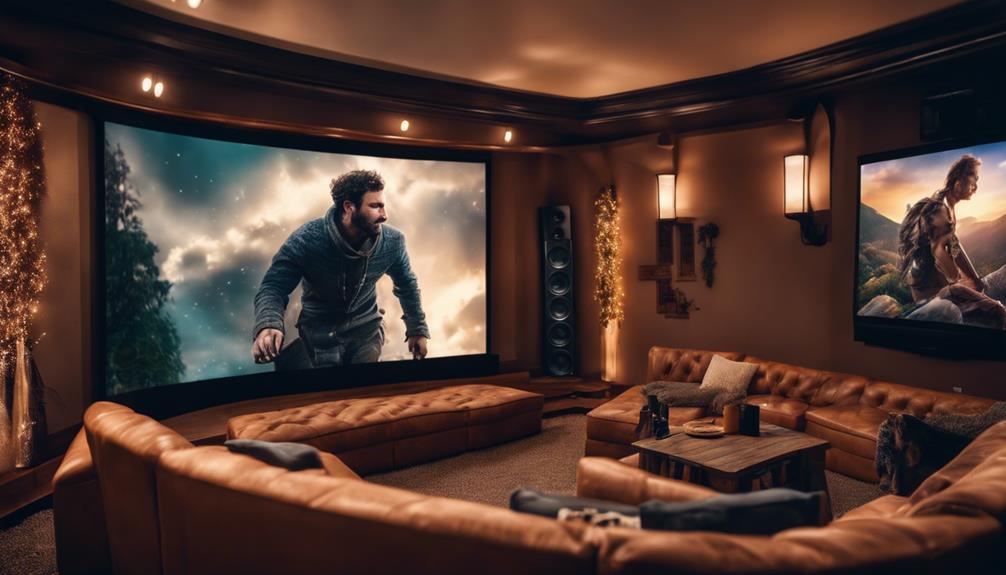
When you watch movies in the cinemascope aspect ratio, you get a wider field of view that pulls you deeper into the story.
This enhanced peripheral engagement makes you feel like you're part of the action, not just a viewer.
With the right setup, your home theater can transform an ordinary film night into an extraordinary immersive experience.
Wider Field of View
Experiencing films in Cinemascope's wider aspect ratio immerses you deeper into the narrative, enhancing the overall emotional impact and visual engagement. This format, typically around 2.35:1, provides a wider field of view, allowing you to take in more of the film's stunning visuals. With fewer black bars on the screen, distractions fade away, letting you focus entirely on the story unfolding before you.
When you set up a larger screen—like a 150-inch diagonal screen—you truly elevate your viewing experience. The expansive horizontal view of Cinemascope invites dynamic compositions, showcasing grand landscapes and intricate details that narrower formats can't capture. You'll find yourself enveloped in the cinematic world, feeling as if you're part of the action.
Studies show that viewers report heightened emotional responses when watching films in this format. The immersive qualities of a wider field of view contribute to a richer experience, making you more connected to the characters and their journeys. So, whether it's a breathtaking epic or an intimate drama, watching in Cinemascope transforms your home theater into an enchanting escape.
Enhanced Peripheral Engagement
Cinemascope's wider aspect ratio actively engages your peripheral vision, drawing you deeper into the film's expansive visuals and enhancing the immersive experience.
With a 2.35:1 aspect ratio, this wide format fills your entire field of vision, allowing you to become fully absorbed in the story. It's not just about what's in front of you; it's about what surrounds you.
Studies have shown that wider aspect ratios improve viewer satisfaction and emotional connection, mimicking the feeling of watching films in traditional theaters.
When you experience a 150-inch diagonal screen with this format, the cinematic feel intensifies, making every scene more impactful. You'll feel like you're part of the action, rather than just an observer.
Additionally, using a Cinemascope screen minimizes those annoying black bars during wide-format films, maintaining visual continuity and enhancing your immersion.
Larger screens, as recommended by THX, further amplify this effect, ensuring you're not just watching but living the experience.
Embracing Cinemascope in your home theater transforms how you engage with films, offering a rich, immersive experience that pulls you right into the heart of the narrative.
Better Compatibility With Films
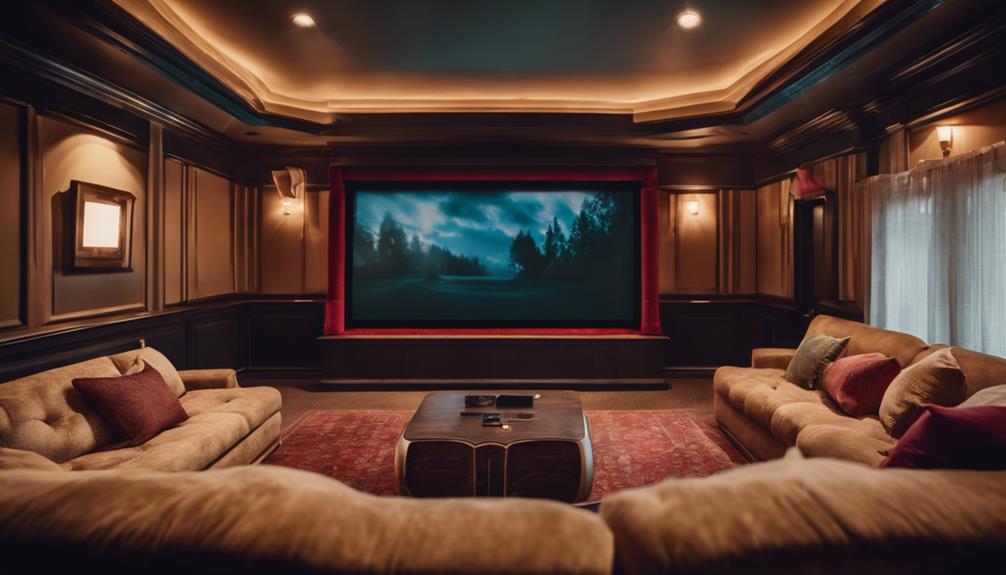
Investing in a cinemascope setup means you'll enjoy a seamless viewing experience with films that match the popular 2.4:1 aspect ratio, minimizing those annoying black bars.
With the majority of blockbuster films produced in wide formats, a cinemascope screen is perfect for showcasing these visuals without cropping content or sacrificing image quality. You'll appreciate how a 2.4:1 aspect ratio maximizes your screen real estate, allowing you to experience the full cinematic vision intended by filmmakers.
Cinemascope offers better compatibility with a diverse range of content. It accommodates both widescreen films and standard 16:9 material, ensuring minimal distortion or cropping.
This versatility means you can switch between formats without compromising your viewing experience. By investing in this setup, you'll also avoid the common issue of pillar boxing, where black bars appear on the sides during standard content playback.
Ultimately, a cinemascope screen enhances your home theater setup, providing a wide, immersive experience that aligns with the formats of modern cinema. Enjoying films as they were meant to be seen makes all the difference in your overall viewing pleasure.
Optimal Use of Large Screens

When you use a large screen with a Cinemascope aspect ratio, you enhance your immersion in the film like never before.
This format is ideal for cinematic movies, showcasing rich visuals and enthralling storytelling.
Plus, with versatile viewing options, you can enjoy a seamless experience that keeps you engaged throughout.
Enhanced Immersion Experience
Utilizing a large screen with a 2.35:1 aspect ratio greatly enhances your immersion by engaging your peripheral vision and drawing you deeper into the cinematic experience.
When you watch films formatted in Cinemascope, your surroundings fade away, making you feel like you're part of the action.
Here are some key benefits of a larger screen in conjunction with the Cinemascope aspect ratio:
- Wider Field of View: You get an expansive visual experience that mimics the traditional cinema setting, allowing for a more engaging viewing experience.
- Enhanced Depth and Scale: A 150-inch diagonal screen amplifies the sense of depth, pulling you further into the storyline and making each scene feel more significant.
With these advantages, you'll find that the immersive experience provided by a large screen and the Cinemascope aspect ratio transforms your home theater into an enchanting cinematic escape.
Ideal for Cinematic Movies
The Cinemascope aspect ratio truly shines on large screens, making it perfect for experiencing cinematic movies in all their glory. With a 2.4:1 ratio, you gain a wider field of view that enhances your immersion. This is especially noticeable on a 150-inch diagonal screen, where the expansive visuals create a spectacle reminiscent of a theater environment.
You'll love how the Cinemascope aspect ratio minimizes black bars during playback of wide-format films, leading to more enjoyable watching. Many modern blockbusters are shot in these wider formats, allowing you to appreciate rich visuals and sweeping landscapes without sacrificing image quality. This setup not only enhances the visuals but also elevates the emotional impact of the films, as you feel enveloped by the cinematography and storytelling.
Incorporating a Cinemascope aspect ratio into your home theater transforms your movie nights, making them more engaging and immersive. So, if you want to enjoy cinematic experiences as intended, investing in a setup that supports this aspect ratio is a game-changer. You'll find yourself drawn deeper into every scene, making each film an unforgettable adventure.
Versatile Viewing Options
Cinemascope's versatility makes it ideal for large screens, letting you fully enjoy a range of film formats while maximizing your viewing experience. With a 2.4:1 aspect ratio, cinemascope fills your peripheral vision, creating a truly immersive atmosphere that transforms your home theater into a cinematic haven.
When you opt for a large screen setup, you'll benefit from:
- Reduced Black Bars: Watch wide-format films without the distraction of black bars, enhancing your visual engagement.
- Improved Detail Visibility: A 150-inch diagonal screen showcases cinemascope content, providing a considerably larger image area that heightens detail and cinematic impact.
Not only does implementing a cinemascope setup elevate your viewing experience, but it also enhances the aesthetics of your room. A larger screen becomes a focal point, inviting friends and family to gather for movie nights, making your home theater a true entertainment hotspot.
Enjoy the best of both worlds with cinemascope!
Advantages for Home Theater Design
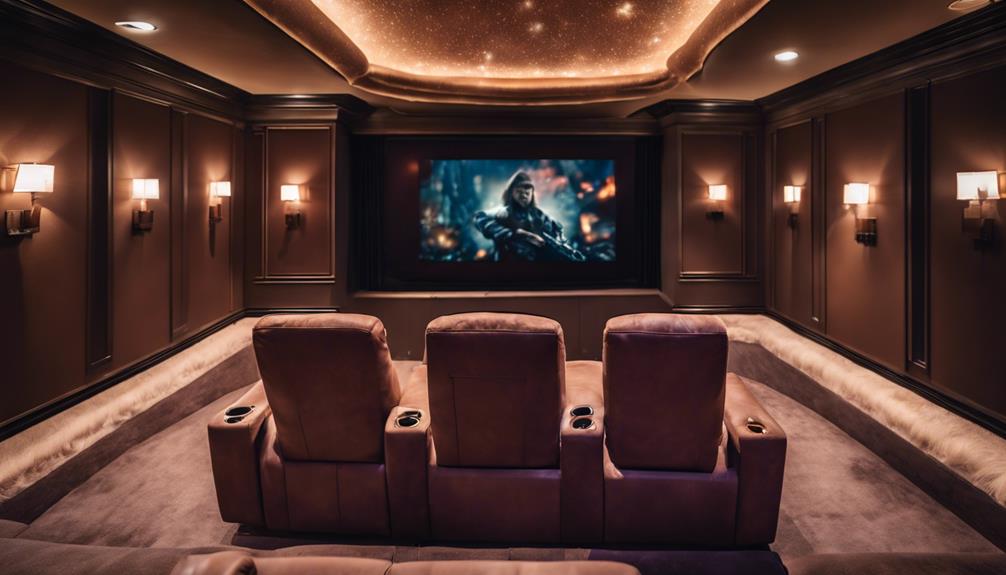
Choosing a cinemascope aspect ratio for your home theater design instantly enhances your viewing experience, making it feel more like a real cinema. This 2.35:1 ratio provides a wider viewing area, immersing you deeper into the film. With minimal black bars, you maximize screen usage, ensuring that every frame captivates your attention.
Here's a quick comparison of the advantages of using a cinemascope aspect ratio in home theaters:
| Feature | Benefits | Impact on Viewing Experience |
|---|---|---|
| Wider Viewing Area | Enhances immersion | Feels like a cinema experience |
| Minimal Black Bars | Maximizes screen usage | More engaging visuals |
| Larger Screen Sizes | Complements screens up to 150 inches | Engages peripheral vision |
| Lens Memory Technology | Seamless shifts between ratios | Flexible content viewing options |
| Ideal for Film Lovers | Optimizes viewing for widescreen films | Perfect for modern cinematic releases |
Addressing Black Bar Concerns

Black bars can be a concern when watching 2.35:1 films on a 16:9 screen, but they actually preserve the film's original composition while enhancing your overall viewing experience. Instead of cropping the image, those black bars maintain the artistic integrity of the film. Many viewers prefer this full image presentation, as it allows them to enjoy the filmmaker's vision without losing significant visual information.
Here are a few reasons why you shouldn't fret about black bars:
- Preserves Film Integrity: Keeping the original aspect ratio respects the director's artistic choices.
- Enhances Immersion: The wider field of view can draw you into the cinematic experience more effectively.
Understanding that many films are produced in wider formats like 2.35:1 can help you make informed decisions about your home theater setup. Embracing the black bars can ultimately lead to a more authentic viewing experience, enabling you to appreciate films as they were meant to be seen.
Future Trends in Home Theater

As home theater technology evolves, you'll likely see a surge in wider aspect ratio screens and projectors designed to maximize your cinematic experience.
With the increasing popularity of 21:9 TVs, you're in for a treat as these models provide a more immersive viewing experience that closely aligns with the 2.4:1 cinemascope aspect ratio preferred for films. This shift caters not only to movie lovers but also to gamers, who appreciate the expansive field of view.
Advancements in projector technology are also making it easier for you to enjoy different aspect ratios without sacrificing image quality. Features like lens memory allow seamless switching between formats, minimizing those pesky black bars. As filmmakers produce more content in wider formats like 2.35:1, your home theater setup can adapt accordingly.
Moreover, the trend towards immersive audio systems, such as Dolby Atmos, will further enhance your experience. Pairing these audio systems with wide aspect ratio screens transforms your viewing into a truly cinematic event.
As you explore these future trends, you'll find that creating an unparalleled home theater experience is more achievable than ever.
Frequently Asked Questions
What Aspect Ratio Is Best for Home Theater?
For a home theater, the best aspect ratio often depends on your viewing preferences. If you prioritize cinematic experiences and enjoy wide-format films, you might prefer a 2.4:1 ratio over the standard 16:9.
What Are the Benefits of Cinemascope?
Imagine watching a stunning sunset. Cinemascope brings that expansive beauty to life. It immerses you in the story, enhances visuals, and captures the filmmaker's vision, making each film feel like an unforgettable experience.
What Is the Best Aspect Ratio for Cinema?
When it comes to cinema, the best aspect ratio is often 2.4:1. It enhances your viewing experience by providing a wider field of view, bringing epic landscapes and detailed scenes to life on screen.
What Is the Difference Between 2.35 and 16:9 Screen?
The difference between 2.35 and 16:9 screens lies in their width. 2.35 offers a wider view, enhancing cinematic visuals, while 16:9 is standard for TV, focusing more on conventional broadcasts and streaming content.
Conclusion
Incorporating the Cinemascope aspect ratio into your home theater can truly elevate your viewing experience.
By embracing this wider format, you're not just watching a film—you're stepping into a story.
The benefits of ideal screen use and compatibility with various films make it a smart choice for any cinephile.
So, why settle for less when you can enjoy a more immersive adventure right at home?
Transform your space and let the magic of cinema unfold!
Tom is the Editor-in-Chief of 1home Theatre Projector, a website that provides news and reviews on the best home cinema experiences. With over 10 years of experience in the industry, Tom knows what makes a great home theatre projector and wants to make it easy for everyone to build the perfect setup for their needs. When he’s not busy writing or testing projectors, Tom enjoys watching classic films and spending time with his family.
